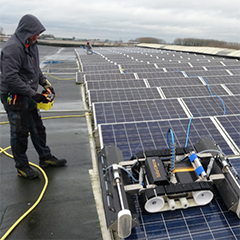The craze for solar panels begins in the 1980s. Following the oil shocks, electricity produced by ‘alternative’ sources appears to be an effective long-term solution. The first MW of production at the world level is reached in 1999. The United States, a pioneer in the field to the point of owning 21% of the total photovoltaic surface area in 1983, is quickly caught up by Germany, and today by China, which now produces 29.7% of the world’s solar energy (figures
from 2017). A directly correlated issue to the rising number of solar panels is their long-term maintenance in order to ensure ongoing efficiency. Therefore, the way to keep them clean.
At the time of the photovoltaic ‘boom’, knowledge about the maintenance of solar panels is very limited. Until 2010, the most widespread opinion is that solar panels do not need to be cleaned because ‘wind and rain water clean them’. This argument by solar panel producers is commonly accepted, although experiences with other objects left outside over a period of time seem to prove it wrong. For example, a car parked outside will show traces of dirt despite being subject to rain and wind.
After several years of using solar panels, owners of solar power plants begin to notice a drop in production and fouling of the installed panels. In some regions of the world, where dirt accumulates rapidly under the effect of wind while maintaining a high degree of sunshine, values of decrease in energy production of up to -30% are detected.
As there is no solution available on the market at this time, the job of cleaning the technical surface of the solar panels is given to professional cleaners. Due to the sensitivity and high investment costs of the solar panels, cleaners exclusively use
manual brushes. Not knowing yet the impact of machine cleaning on solar panels, it is believed to be the safest way to clean
without damaging the panel.



























